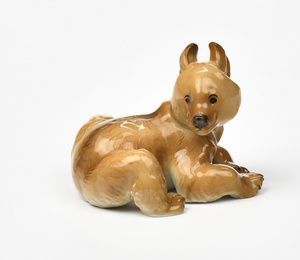Фарфоровая мануфактура в Аллахе
Фарфоровая мануфактура в Аллахе
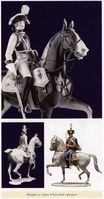
Фарфоровая мануфактура в Аллахе
Пришедшие к власти в 1933 году национал-социалисты начали насаждатьв Германии новую идеологию. Строгая регламентация и жесткий контроль каждой области человеческой жизни и деятельности способствовали созданию необыкновенно меткой структуры общества, что нашло отражение, в первую очередь, не в монументальном искусстве, а искусстве малых форм, в произведениях декоративных, в предметах быта.
 Отличительная особенность всех тоталитарных систем — стремление не только сформировать свое официальное искусство, но и проникнуть в каждую область жизни человека, в том числе частную. Так, например, каждая пара молодоженов была обязана при регистрации брака приобрести «Майн кампф», повесить у себя в доме портрет фюрера.
Отличительная особенность всех тоталитарных систем — стремление не только сформировать свое официальное искусство, но и проникнуть в каждую область жизни человека, в том числе частную. Так, например, каждая пара молодоженов была обязана при регистрации брака приобрести «Майн кампф», повесить у себя в доме портрет фюрера.
Вещь, как объект повседневного пользования, тоже оказалась вполне действенным средством манипулирования массовым сознанием. Даже предметы быта были «призваны к идейному служению» новому порядку. Выбор тем и форм, мотивов и способов декорирования предметов каждодневного пользования — все это в комплексе должно было отражать идеи величия германского народа, военную и гражданскую мощь молодого нацистского государства, его тесную связь с империей древних римлян.
Наиболее наглядно идеология новой власти отразилась в развернутой системе символов. Самыми распространенными среди них стали свастика (древний солярный знак, в древних цивилизациях связанный с идеей бесконечности движения и, следовательно, аккумулировавший в себе потенциальную энергию), орел (спутник верховного бога-громовержца Зевса/Юпитера, имперский символ со времен античности), крест (древний символ четырех сторон света, четырех стихий, древа жизни и всякого могущества), венок или листья дуба (дерева, в понимании немцев, символизирующего жизненную силу и бессмертие), мечи (символ военного успеха), к которым добавлялись узнаваемые знаки разных областей деятельности человека — подводная лодка, торпедный корабль, мотивы герба города, голова греческой богини мудрости Афины и другие.
Особенностью изделий из фарфора, выпускавшихся заводами Третьего рейха, была не только изобразительная символика. Сам выбор тем и мотивов произведений мелкой пластики и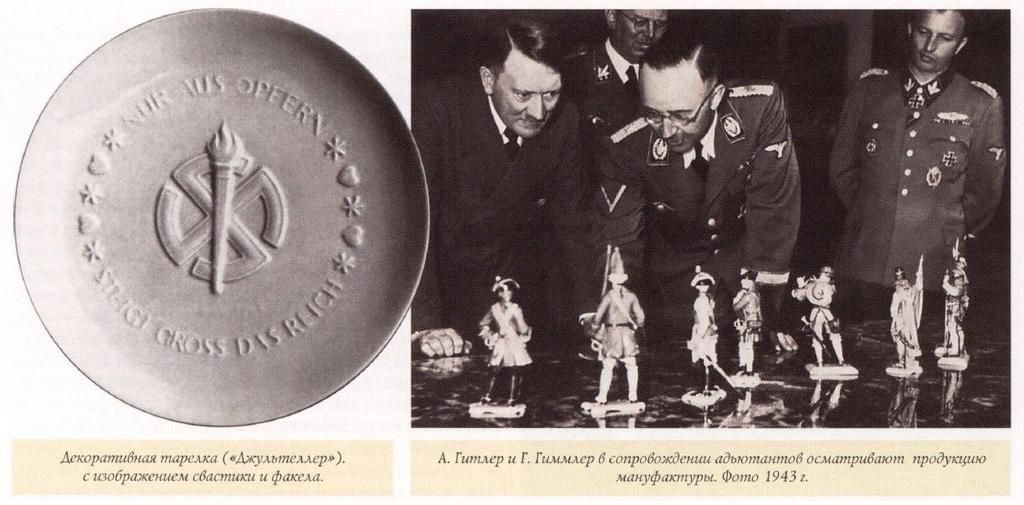 вотивных тарелок и плакеток, формы подсвечников и посуды отражали как общеполитические идеи тоталитарного строя Германии, так и характер частной жизни, бытового уклада эпохи.
вотивных тарелок и плакеток, формы подсвечников и посуды отражали как общеполитические идеи тоталитарного строя Германии, так и характер частной жизни, бытового уклада эпохи.
Среди многочисленных фарфоровых заводов тогдашней Германии безусловное первенство, по крайней мере, с идейной точки зрения, принадлежало мануфактуре Аллах-Мюнхен, считавшейся «предприятием СС» (к ним также относились предприятие по выпуску минеральной воды «Аполлинарис», мебельная фабрика «Эдель», издательство «Нордланд», фирма изготавливавшая мечи для внутренних нужд СС).
Официально мануфактура, основанная по личному распоряжению Г.Гиммлера и бывшая его «любимым детищем», начала работать 3 января 1936 года. Однако известно, что как частное предприятие она функционировала и до получения статуса главного фарфорового предприятия страны. Об этом свидетельствуют образцы его изделий 1934 года (в частности, одна из самых известных фигур — «Знаменосец»), а также зафиксированные в бухгалтерских книгах счета за 1935 год. Среди основателей мануфактуры были личный друг Г. Гиммлера художник Карл Дибич, скульптор и модельер Теодор Кэрнер, и еще два компаньона — коммерсанты Бруно Гальке и Франц Надь.
До 20 декабря 1938 года фабрика находилась в ведении культурного отдела (под управлением К. Дибича) личного штаба рейхсфюрера СС Г.Гиммлера, одновременно числившегося художественным руководителем мануфактуры. Однако официально руководить этим предприятием Г. Гиммлер стал лишь в 1938 году, когда оно перешло под начало Службы управления и экономики СС (1939—1942, позже и до 1945 года именовавшейся Службой экономического управления СС). Мануфактура была призвана в первую очередь служить целям политической пропаганды, развития вкуса и повышения культурного уровня истинных арийцев (причем не рядовых членов немецкого общества, а избранных — членов СС). То есть экономическая выгода предприятия не играла особой роли. Хотя известно, что перед войной предприятие получало прибыль до 100%.
Доходность фабрики значительно снизилась в годы войны, особенно в начале 1940-х годов, из-за сокращения финансирования и мобилизации ее работников. Именно тогда на предприятии начали широко использовать труд заключенных расположенного поблизости концлагеря Дахау. По воспоминаниям некоторых из них, эта практика зародилась еще в 1939 году, но если в начале 1941 года на фабрике работали двое-трое заключенных, то к осени 1941-го их было 40—50, а в 1943 году — уже 100 человек. Считалось, что одного обычного рабочего можно было заменить двумя или даже тремя заключенными. Известно i также, что, несмотря на неудовольствие Г.Гиммлера, многие из них занимали порой довольно значительные должности. Более того, благодаря работе на фабрике они фактически спаслись от смерти. Так, например, в бухгалтерии мануфактуры трудился Карл Адольф Гросс, который в своих воспоминаниях рассказывал о польском студенте Иозефе Собчаке, который занимался росписью фарфора. Другие были заняты на обжиге, литье и шлифовке. А заключенный Ганс Ландауэр был допущен к изготовлению даже идейно значимых фигур.
О последних годах работы мануфактуры мало что известно. С окончанием войны она, как нацистское предприятие, прекратила свое существование.
Об истории и характере фарфорового производства лучше всего говорят сами вещи. Наиболее значимые из них сегодня — большая редкость на антикварном рынке. Это объясняется, в первую очередь, ограниченным тиражом «элитных» изделий (за исключением выпускавшихся для широкой продажи фигурок животных), многочисленными бомбардировками Мюнхена и разрушениями на исходе войны. Известно также, что так называемые «политические» фарфоровые фигуры начали уничтожать еще в годы войны. В ее огне погибли не только сами изделия из фарфора, но и почти весь архив мануфактуры. Некоторые из документов предприятия были уничтожены служащими, заметавшими следы совершенных ими финансовых преступлений.
Единственный дошедший до наших дней оригинальный перечень изделий — это каталог 40 изделий мануфактуры 1936 года. Но он совершенно недоступен для исследователей: каталог был в личной коллекции книг А.Гитлера, впоследствии оказался в Библиотеке Конгресса США и до сих пор относится к числу засекреченных документов. Главными источниками сведений об изделиях этой мануфактуры по сей день остаются: воспоминания современников, неоднократно переизданный каталог 1937 года, его варианты и приложения 1938 и 1939 годов (Porzellan-Manufaktur Allach-Munchen. Verzeichnis der Erzeugnisse. Liste 1938/39. Verlag ?) и, конечно же, сами изделия, большинство из которых разошлось по частным коллекциям.
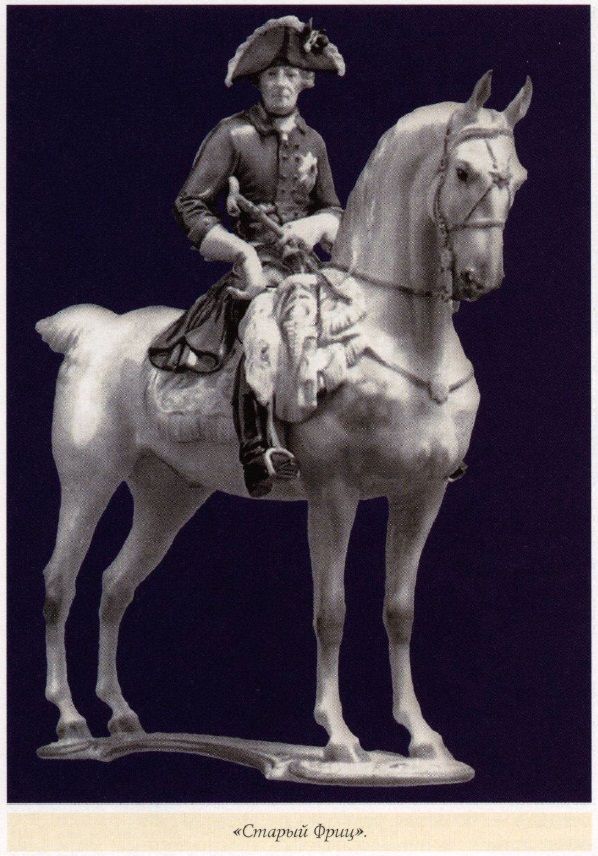 Самый полный сводный список моделей мануфактуры за разные годы насчитывает около 240 керамических и фарфоровых изделий. Приоритетным направлением Аллахской мануфактуры было производство мелкой пластики из фарфора. Предназначенные чаще всего для подарков высокопоставленным лицам государства, изделия были призваны отражать главные идеи нацистского движения. Это были фигурки военных разных эпох и герои современности, немецкие крестьяне и ремесленники, купальщицы и танцоры, античные боги и геральдические фигуры германских городов, символические образы и разнообразные животные. В задачу «предприятия СС» входило и изготовление целого ряда знаковых наградных изделий — декоративных тарелок и плакеток с соответствующим случаю декором. И если фарфоровая пластика мануфактуры сегодня — большая редкость, то эти изделия — просто уникальны, ибо изготовляли их обычно в единичных экземплярах. Массовым можно было бы назвать лишь производство на Аллахе светильников и ваз, которое тоже отвечало требованиям идеологической пропаганды. Посуду здесь почти не делали, разве что по личному заказу шефа СС или самого фюрера. Все изделия из фарфора (за исключением фигурки «Фехтовальщик») покрывали глазурью, часть расписывали, другие оставляли белыми.
Самый полный сводный список моделей мануфактуры за разные годы насчитывает около 240 керамических и фарфоровых изделий. Приоритетным направлением Аллахской мануфактуры было производство мелкой пластики из фарфора. Предназначенные чаще всего для подарков высокопоставленным лицам государства, изделия были призваны отражать главные идеи нацистского движения. Это были фигурки военных разных эпох и герои современности, немецкие крестьяне и ремесленники, купальщицы и танцоры, античные боги и геральдические фигуры германских городов, символические образы и разнообразные животные. В задачу «предприятия СС» входило и изготовление целого ряда знаковых наградных изделий — декоративных тарелок и плакеток с соответствующим случаю декором. И если фарфоровая пластика мануфактуры сегодня — большая редкость, то эти изделия — просто уникальны, ибо изготовляли их обычно в единичных экземплярах. Массовым можно было бы назвать лишь производство на Аллахе светильников и ваз, которое тоже отвечало требованиям идеологической пропаганды. Посуду здесь почти не делали, разве что по личному заказу шефа СС или самого фюрера. Все изделия из фарфора (за исключением фигурки «Фехтовальщик») покрывали глазурью, часть расписывали, другие оставляли белыми.
Керамические вещи этого предприятия — тоже большая редкость сегодня. В этой технике здесь были исполнены одни из самых ответственных произведений мануфактуры: имперский орел и голова А.Гитлера, а также светильник «Джульлёйхтер», ставший символом нового уклада общества и самым растиражированным товаром мануфактуры. Примечательно, что их не покрывали глазурью, словно имитировали технику древнейших изделий первых германских племен.
Славное прошлое
Одной из главных тем фарфоровой пластики, составившей гордость Аллахской мануфактуры, были фигурки военных, изображавших знаменитых в прошлом конкретных деятелей, а также собирательный образ представителей разных родов войск. В рамках новой нацистской идеологии тема воспитания идеального солдата на достойных примерах из прошлого стала особенно популярной уже с начала 1930-х годов. В то время декоративные фигурки солдат, украшавшие столы, комоды, камины и т.д., начали появляться в ассортименте самых разных немецких мануфактур (среди них — Мейсен, Нимфенбург, Эльтесте Пор- целанфабрик, Худлер и др.), в том числе и в стекольном производстве (Розенталь). Не стала исключением и мануфактура Аллаха, где на изготовление «фарфоровых солдатиков» были брошены лучшие силы.
Почти все ее «военные» были исполнены по рисункам и моделям лучшего мастера производства — Теодора Кэрнера или, в порядке исключения, его ученика Рихарда Фёрстера. Первый отвечал за изготовление всадников, второй — пехотинцев. Необходимо отметить, что после 1942— 1943 годов больше нет указаний на модели Кэрнера, так что, видимо, Фёрстер был с тех пор автором и фигурок всадников, и фигурок пехотинцев. Три фигуры из серии пехотинцев (1943—1944) создал Адольф Рёрунг, чье имя упоминается в каталоге 1938—1939 годов рядом с фигуркой лошади, которую седлают, и фигурками птиц (дрозда, зеленушки).
Популярная в искусстве фарфоровой пластики еще с XVIII века тема «конного памятника» (Мейсен, Нимфенбург) приобрела в нацистской Германии, наследовавшей традиции античной культуры, триумфальное и даже героическое значение. Она была самой любимой и У Кэрнера. Во вступлении к послевоенному каталогу его произведений можно прочитать: «Изображение всадников в костюмах своего времени — это особенно любимая мастером область». Г.Гиммлер тоже не раз подчеркивал, что кавалеристы — это лучшее, что делал главный художник его любимого фарфорового завода. А представленная на Большой выставке немецкого искусства в 1941 году картина мастера с изображением конного связного даже была приобретена Имперской канцелярией.
Работавший раньше в Нимфенбурге и на Розентале Т.Кэрнер исполнил для Аллаха модели всех фигур гусаров, а также драгуна, кирасира, пандура (словенского пехотинца) и знаменитого «Старого Фрица».
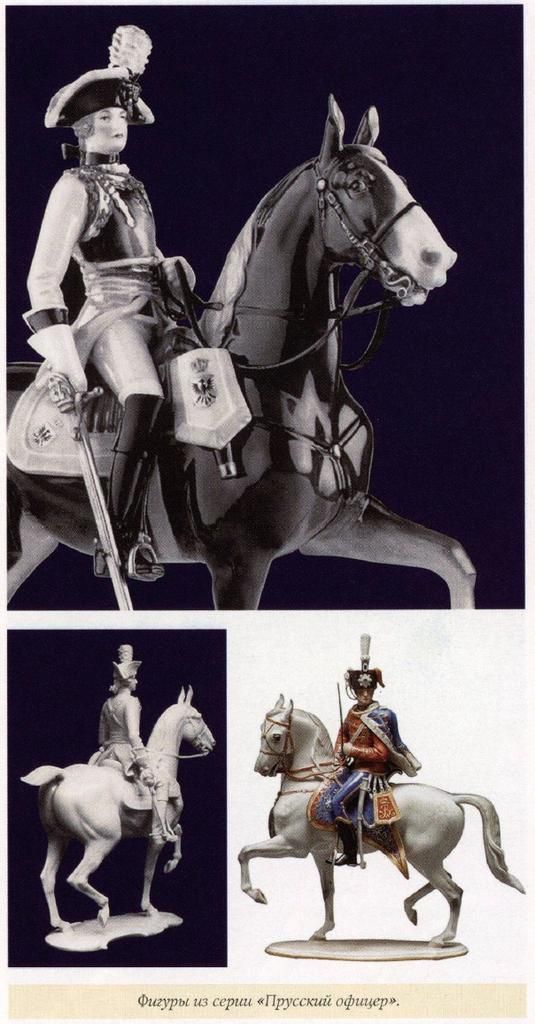 Главными героями кэрнеровской пластики стали прусский король Фридрих Великий и его лучшие солдаты. Старый Фриц — любовное прозвище, данное королю Фридриху солдатами еще при его жизни, стало и названием фарфоровой статуэткиТ. Кэрнера. В «мифологии» Третьего рейха Фридрих Великий олицетворял сугубо германские добродетели правителя: любовь к отечеству, народу и культуре. В 1932 году И. Геббельс назвал его «первым наци». Сам Гитлер ассоциировал себя с ним, считая себя его духовным сыном. Известно, что в новой канцелярии в кабинете фюрера висела картина А.Менцеля, на которой был Фридрих Великий, а на ломберном столике под стеклянным колпаком стояло его же фарфоровое изображение (производства Эльтесте Порцеланфабрик, Фолькштадт). Эти аналогии услужливо проводились и в массовой культуре. Так, например, на сохранившемся рекламном плакате Эльтесте Порцеланфабрик в Фолькштадте можно увидеть витрину, в центре которой изображен Фридрих Великий. Перед ней — два портретных бюста: его же и Гитлера, представленного здесь в качестве последователя прославленного короля-военачальника Левее стоит курпфальцский охотник, правее — великий курфюрст (Фридрих Вильгельм I), еще раз Фридрих Великий, Зейдлиц и другие известные гусары, генералы короля. Все вместе они были призваны олицетворять преемственность германской истории и подчеркивать величие своей нации, а не конкретных людей. Популяризация образа великого короля началась еще в конце 1920-х годов: появились художественные и документальные фильмы, рассказывавшие о его жизни и деяниях, гравюры с изображением Фридриха и его войск и, конечно же, фарфоровые статуэтки, изготавливавшиеся на разных мануфактурах как по новым моделям, так и по образцам XVIII века. Воспроизведение моделей того века мы встречаем на мануфактурах Мейсена, Фюрстенберга, в Розентале (по модели Луиса Туайлона), а также в ассортименте менее известных фабрик: Кохендорфер в Остерроде или Аккерман и Фрице в Рудольштадте. Королевская фарфоровая мануфактура в Берлине начала воспроизводить даже те предметы, которыми пользовался сам король, или создавать по их образцу новые.
Главными героями кэрнеровской пластики стали прусский король Фридрих Великий и его лучшие солдаты. Старый Фриц — любовное прозвище, данное королю Фридриху солдатами еще при его жизни, стало и названием фарфоровой статуэткиТ. Кэрнера. В «мифологии» Третьего рейха Фридрих Великий олицетворял сугубо германские добродетели правителя: любовь к отечеству, народу и культуре. В 1932 году И. Геббельс назвал его «первым наци». Сам Гитлер ассоциировал себя с ним, считая себя его духовным сыном. Известно, что в новой канцелярии в кабинете фюрера висела картина А.Менцеля, на которой был Фридрих Великий, а на ломберном столике под стеклянным колпаком стояло его же фарфоровое изображение (производства Эльтесте Порцеланфабрик, Фолькштадт). Эти аналогии услужливо проводились и в массовой культуре. Так, например, на сохранившемся рекламном плакате Эльтесте Порцеланфабрик в Фолькштадте можно увидеть витрину, в центре которой изображен Фридрих Великий. Перед ней — два портретных бюста: его же и Гитлера, представленного здесь в качестве последователя прославленного короля-военачальника Левее стоит курпфальцский охотник, правее — великий курфюрст (Фридрих Вильгельм I), еще раз Фридрих Великий, Зейдлиц и другие известные гусары, генералы короля. Все вместе они были призваны олицетворять преемственность германской истории и подчеркивать величие своей нации, а не конкретных людей. Популяризация образа великого короля началась еще в конце 1920-х годов: появились художественные и документальные фильмы, рассказывавшие о его жизни и деяниях, гравюры с изображением Фридриха и его войск и, конечно же, фарфоровые статуэтки, изготавливавшиеся на разных мануфактурах как по новым моделям, так и по образцам XVIII века. Воспроизведение моделей того века мы встречаем на мануфактурах Мейсена, Фюрстенберга, в Розентале (по модели Луиса Туайлона), а также в ассортименте менее известных фабрик: Кохендорфер в Остерроде или Аккерман и Фрице в Рудольштадте. Королевская фарфоровая мануфактура в Берлине начала воспроизводить даже те предметы, которыми пользовался сам король, или создавать по их образцу новые.
Отличительной особенностью кэрнеровской модели стала композиция, на которой всадник изображен нетрадиционно — не на шагающем коне, а на спокойно стоящем. Король внимательно смотрит вперед и чуть вправо, словно наблюдает ход битвы. Его взгляд целеустремлен, он сосредоточен, но спокоен лишь внешне — все это только усиливает воинственный характер и без того известного своими победами монарха. Для сравнения можно привести всего несколько примеров подобной иконографии короля — гравюру Д.Чодовики, где он изображен на коне среди народа, а также ксилографию А. Менцеля в биографии Куглера.
Аллахская фигура Фридриха пользовалась большим успехом у высокопоставленных эсэсовцев. Известно, что в 1939 году Т.Кэрнер изготовил 36 фигур (32 белых и 4 в цвете). А уже в следующем году фюрер для себя лично заказал 100 таких фигур без росписи.
Офицеры Фридриха — собирательный образ прусских воинов, но есть и фигуры известных в военной истории лиц: готовый к битве, вынимающий шпагу «гусарский офицер фон Цитен» (Ханс Иоахим фон Цитен, 1699— 1786), устремленный вперед «Малаховский гусар» (Пауль Иозеф фон Малаховский, умер в 1774 г.) и готовый к маршу «Офицер кирасиров Зёйдлиц» (Фридрих Вильгельм фон Зёйдлиц, умер в 1728 г.). Фигурка последнего (к его личности деятели рейха, вероятно, и сам Гитлер проявляли особый интерес; его изображение выпускали и другие мануфактуры) стала одной из самых популярных моделей и, возможно, оценивалась даже как одна из лучших фигур мануфактуры. Неслучайно именно на нее были возложены репрезентативные функции — она украшает обложку каталога 1937 года, дважды упоминается внутри, в раскрашенном и нераскрашенном вариантах. Ее производство не прекращалось вплоть до 1945 года, несмотря на то, что это была одна из самых дорогих фигур: белая стоила 7 5 рейхсмарок, цветная—170. В 1938 году было выпущено почти 100 ее экземпляров, в 1939-м — уже 129.
 Образцы униформы времен Фридриха Великого Т.Кэрнер брал с литографий А. Менцеля, которые служили ему детализированным словарем, в чем можно убедиться, внимательно рассмотрев изображение гусара фон Цигена.
Образцы униформы времен Фридриха Великого Т.Кэрнер брал с литографий А. Менцеля, которые служили ему детализированным словарем, в чем можно убедиться, внимательно рассмотрев изображение гусара фон Цигена.
Наряду с литографиями и гравюрами в Аллахе, так же, как и в Нимфенбурге, где некогда работал Кэрнер, в качестве бразцов использовались также изделия прошлых лет, в частности, произведения XVIII века фарфориста Ф.А. Бустелли, который на мануфактуре Нимфенбурга исполнил большое количество моделей охотников на лошадях. Его работы получили высокое признание у лидеров Третьего рейха. Ориентация на эти произведения эпохи рококо проявилась в первую очередь в специфической форме цоколя, декорированного рокайльными завитками. В то же время эти реминисценции служат отсылкой к тому времени, когда жил герой миниатюры, известному как эпоха расцвета немецкого фарфора.
Фигуры пехотинцев Р. Фёрстера, призванные нести в массы идеи сохранения и наследования всех достоинств немецких ландскнехтов, прусских солдат, австрийских воинов и пр., оставались главными изделиями мануфактуры до 1941 года, когда объем производимой продукции стал уменьшаться из-за возникших экономических проблем.
Среди таких фигурок упоминаются «Рыцарь Максимилиан» (император Максимилиан 1 в «мифологии» Третьего рейха — последний националистически настроенный правитель Германской империи), «Ландскнехт», «Бранденбургский мушкетер ок. 1700 года» (оба в униформе нового времени), «Бутлер-драгун эры Валленштейна» — символ бесстрашия и преданности кайзеру. За фигурками эпохи Фридриха следует тема войны за независимость, борьбы с Наполеоном (1806—1812), это: «Драгун 1806 года», «Гренадер баварских линейных войск (Троммлер) 1809 года». «Большой германский рыцарь» — символ великой Германии (объединенной с Австрией).
К числу довольно редких произведений мануфактуры на военную тему относятся фигуры известных немецких полководцев-рыцарей, заказанные Гиммлером в июне 1944 — начале 1945 года: «Принц Евгений» (принц Евгений Мориц фон Савойен-Кариньян, 1663—1736, австрийский полководец и дипломат Леопольда I и Карла VI), «Фрундсберг» (Георг фон Фрундсберг, 1473—1528, «отец немецких ландскнехтов», участник «Сакко ди Рома»), «Гёте фон Берлихинген» (1480—1562, деятель времен Крестьянской войны), «Рыцарь Франц» (Франц фон Зикинген, 1481—1523, герой немецкой Реформации, ревностный борец за секуляризацию). Их имена были присвоены новым дивизионам СС, созданным летом 1943 года, для укрепления в них силы духа и веры в победу.
Весь этот парад войск различных родов и эпох сегодня воспринимается как своеобразная иллюстрация к истории развития военной униформы, которая и сама по себе стала одним из символов гитлеровской Германии. В нацистском государстве ее носили практически все, она стала выражением той строгой иерархичности, расчлененности общества на своеобразные касты или сословия. Ее носили партийные деятели, государственные служащие, чиновники, солдаты, крестьяне. По униформе узнавали о принадлежности человека к какой-либо организации (спортивной, молодежной, женской и др.). Вот почему при изготовлении фигурок в униформе мастера стремились максимально правдоподобно передать в фарфоровой пластике детали костюма и обмундирования.
Герои настоящего
Второй значительной темой аллахского фарфора стали так называемые «образы нацистского движения» (к которым здесь мы относим и фигуры военных современной мануфактуре эпохи).
Среди наиболее важных изделий этой группы в первую очередь стоит назвать «СС-знаменосца», изображение которого является прямой аллюзией мифологизированных событий «Пивного путча», произошедшего 9 ноября 1923 года. В идеологии гитлеровского государства «Кровавому знамени» путча был придан характер реликвии, вызывавшей особое поклонение, «инсигнии» (знака) новой власти. Фарфоровая фигурка знаменосца, исполненная Т. Кэрнером в 1934 году, тоже имела псевдорелигиозное, почти культовое значение. Из поздних каталогов известно, что ее никогда не выставляли на продажу, она могла быть только подарком СС. Было запрещено помещать фигуру в витринах магазинов (известен инцидент с владельцем лавки в Познане Вартенбергом, который навлек на себя гнев Гиммлера, выставив эту фигуру в витрине).
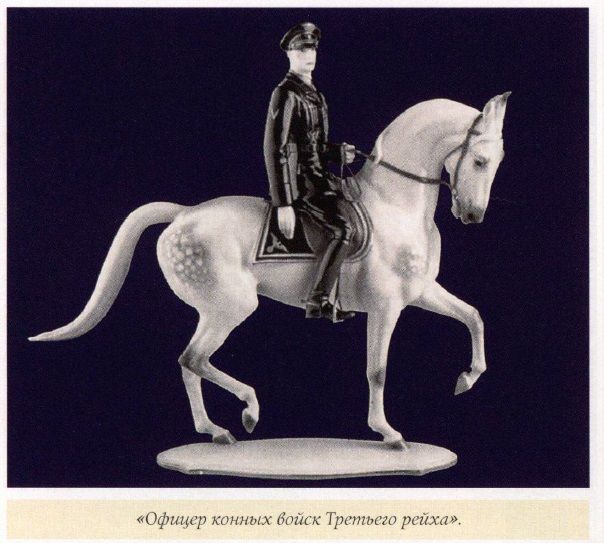 Знаменосец Кэрнера представлен в парадной униформе СС, стальном шлеме, на груди у него — геральдический знак в форме сердца. В правой руке он держит древко знамени, которое не напрямую изображает реликвию, а лишь намекает на нее. В отличие от «исторических фигур» «СС-знаменосец» имеет строгое прямоугольное основание, лишенное историко-стилевых реминисценций и тем самым подчеркивающее актуальность образа. В общей композиции очевидны аллюзии на античную и ренессансную пластику — художник стремился подчеркнуть военный характер фигуры, серьезность, важность и внутреннее достоинство героя.
Знаменосец Кэрнера представлен в парадной униформе СС, стальном шлеме, на груди у него — геральдический знак в форме сердца. В правой руке он держит древко знамени, которое не напрямую изображает реликвию, а лишь намекает на нее. В отличие от «исторических фигур» «СС-знаменосец» имеет строгое прямоугольное основание, лишенное историко-стилевых реминисценций и тем самым подчеркивающее актуальность образа. В общей композиции очевидны аллюзии на античную и ренессансную пластику — художник стремился подчеркнуть военный характер фигуры, серьезность, важность и внутреннее достоинство героя.
Еще одно знаменитое изделие мануфактуры — «Офицер конных войск Третьего рейха», исполненное, возможно, Р.Фёрстером (значит, только после 1942 года), наглядно демонстрирует продолжение традиций. Здесь же появились фигуры и других представителей нацистской армии, например, «Офицер Люфтваффе», «Пилот», «Офицер полиции», «Рабочий» и др.
например, «Офицер Люфтваффе», «Пилот», «Офицер полиции», «Рабочий» и др.
К числу фигур, связанных с символикой и идеологией нацистского движения, безусловно, относится «Фехтовальщик» О.Обермайера. Известно, сколь большое внимание уделял Гитлер физическому развитию нации и спортивной подготовке молодежи. Одним из пунктов «обязанностей государства», сформулированных фюрером в «Майн камф», было «поощрение занятиями спортом среди молодежи до беспрецедентного уровня подготовленности». В государственной политике наметилось своеобразное стирание границ между спортом и военной подготовкой. Идеальная нация должна была быть сильной, крепкой, здоровой и физически развитой. Спорт воспитывает в человеке дисциплину, чувство коллектива, солидарности и волю к победе. Без соответствующего физического развития карьера в СС была невозможна.
Неслучайно для изображения спортсмена на мануфактуре выбрали тему фехтования. Дело в том, что один из членов правительства Третьего рейха — шеф Главного управления имперской безопасности генерал Рейнхард Гейдрих был искусным фехтовальщиком, победителем многих состязаний. Образ Р.Гейдриха, который был не только идеальным примером для подражания в области физического воспитания, но и единственным среди всей партийной верхушки, кто соответствовал представлениям о чистой нордической расе (рост, цвет волос и глаз), пользовался огромной популярностью в нацистской массовой культуре. (Хорошо известен, например, его портрет кисти пражского художника академика Иозефа Витца, который экспонировался на Большой немецкой выставке в Мюнхене в 1941 году. Любопытно, что в качестве атрибута на этом портрете изображена фигурка фехтовальщика, возможно, полученная им как приз на соревнованиях).
Однако Аллахский «Фехтовальщик» — это все же не портрет деятеля Третьего рейха Гейдриха, а идеализированный образ прекрасно развитого спортсмена, на который следовало бы ориентироваться германской молодежи. Он изображен не в момент состязания, его фигура расслаблена, он отдыхает, возможно, после соревнования. Спортивные брюки чуть ниже колена и гладко уложенные волосы выдают в нем современного спортсмена, а обнаженный торс вызывает в памяти совершенных атлетов Древней Греции. Кстати, любопытный факт: фигуры спортсменов (известны еще «Чемпион» и «Метатель диска») — единственные изделия мануфактуры,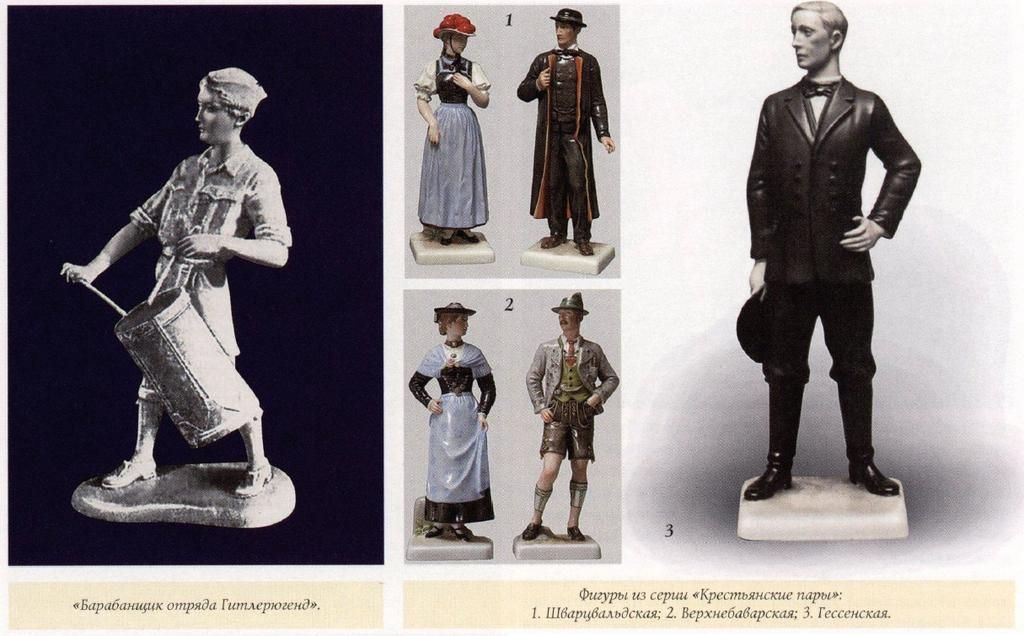 выполненные в технике бисквита, идеально белая пористая поверхность которого имитирует мрамор. Таким образом, фарфоровые атлеты Аллаха — прямые наследники античной пластики. Как и фигуру знаменосца, фигуры спортсменов делали не на продажу, это были ценные призы на соревнованиях.
выполненные в технике бисквита, идеально белая пористая поверхность которого имитирует мрамор. Таким образом, фарфоровые атлеты Аллаха — прямые наследники античной пластики. Как и фигуру знаменосца, фигуры спортсменов делали не на продажу, это были ценные призы на соревнованиях.
Серию «фигур нацистского движения» дополняют изображения разнообразных служащих Третьего рейха (Т. Кэрнер), а также членов Гитлерюгенда и Союза немецких девушек (Р. Фёрстер). Все они, как и военные, облачены в униформу, указывающую на их положение и роль в обществе. Изображения представителей самых широких слоев общества тоже трактовались как национальные символы, ибо это — опора государства, которому в будущем уготовано мировое господство. Такие фигурки можно было встретить в свободной продаже, их выпускали гораздо большим тиражом. Они должны были быть недорогими, доступными простому населению, представителям всех социальных групп. Большая редкость — более дорогие раскрашенные фигуры. Согласно каталогам, раскраска удорожала изделия почти вдвое, что делало их менее доступными по цене, по- | этому их мало изготавливали.
Апология мещанского быта, или символы и аллегории
Наряду с такой явно идеологической продукцией мануфактура выпускала целый ряд других изделий, не так прямолинейно выражавших милитаристский характер эпохи. В ее ассортименте — декоративные фигурки скорее развлекательного, нежели идеологического характера: танцоры, «ню», национальные типажи и так далее.
В первую очередь, это крестьянские фигуры, восходящие к традиционным мотивам «пейзан» в искусстве фарфора. Все они изображены в национальных костюмах, которые в данном случае носили не этнографический, а символический характер, то есть персонажи символизировали германскую нацию, связь с родиной, ее традициями, землей. В этой серии, выполненной по моделям Р. Фёрстера (фигурки этнических типажей — перса, индуса и яванца — он изготавливал еще в 1924 году, когда работал на мануфактуре в Розентале), известны так называемые бюкебургская пара, верхнебаварская, шварцвальдская, гессенская и фризская. Возможно, серия была продолжена, но о других моделях сведений нет.
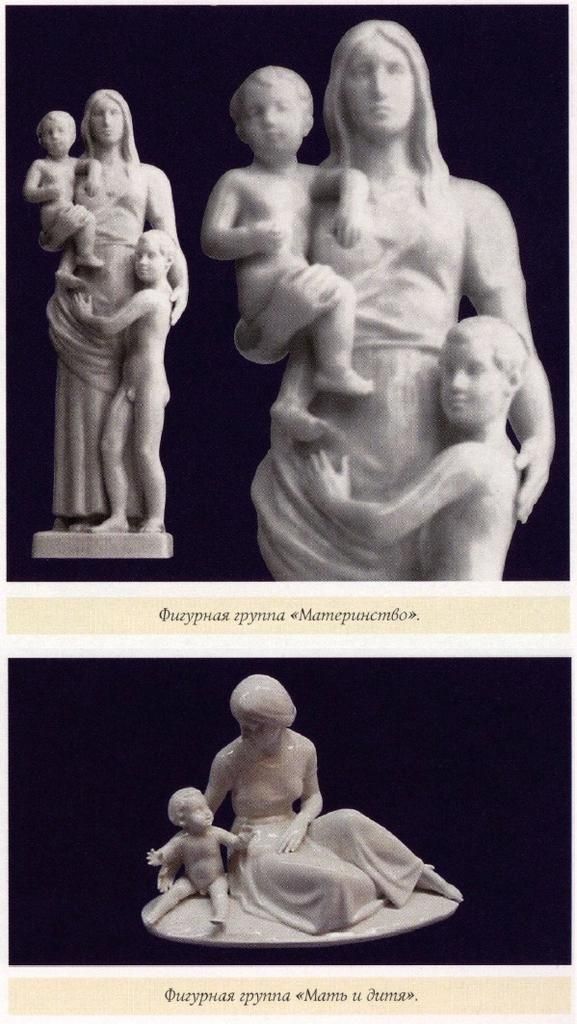 Надо сказать, что в Аллахе крестьянские фигурки изготавливали не только раскрашенными, как это было принято при выпуске традиционных изделий, в которых отличительные черты зачастую основывались на разнообразии цветных деталей пестрого платья. Чаще их выпускали в нераскрашенном варианте из белого глазурованного фарфора. И, несмотря на большую популярность цветных изделий, в каталогах их предлагали белыми, тем самым подчеркивая не столько их занимательность, сколько воплощение абстрактной идеи, для которой более уместны простота материала и лаконичность декора. Отсутствие развлекательного фольклорного мотива делает эти фигуры чем-то похожими на политические. Причем это сходство просматривается и в их внешнем облике — они так же серьезны, их фигуры неподвижны, позы торжественны. Жесткий геометризованный квадратный цоколь еще больше усиливает это впечатление. Крестьянин Аллаха — это не образ идеального крестьянина, а скорее символическое выражение национальных черт и истоков.
Надо сказать, что в Аллахе крестьянские фигурки изготавливали не только раскрашенными, как это было принято при выпуске традиционных изделий, в которых отличительные черты зачастую основывались на разнообразии цветных деталей пестрого платья. Чаще их выпускали в нераскрашенном варианте из белого глазурованного фарфора. И, несмотря на большую популярность цветных изделий, в каталогах их предлагали белыми, тем самым подчеркивая не столько их занимательность, сколько воплощение абстрактной идеи, для которой более уместны простота материала и лаконичность декора. Отсутствие развлекательного фольклорного мотива делает эти фигуры чем-то похожими на политические. Причем это сходство просматривается и в их внешнем облике — они так же серьезны, их фигуры неподвижны, позы торжественны. Жесткий геометризованный квадратный цоколь еще больше усиливает это впечатление. Крестьянин Аллаха — это не образ идеального крестьянина, а скорее символическое выражение национальных черт и истоков.
Среди декоративных фигур Аллаха встречаются и обнаженные изображения, как совершенно непритязательные развлекательные аллегории, так и имеющие античные аллюзии серьезные программные композиции. К ним относится аллегорическая серия «Времена года», исполненная по моделям Ф. Наги. У каждой из четырех изящных фигурок — приметы сезона: у весны — флейта и птичка на цоколе, у лета — соломенная шляпка, серп и колосья, у осени — убитый зайчик и дубина (примечательно отсутствие традиционных вакхических мотивов), у зима — костер. Известно, что «Времена года» выпускали только в 1937 году и только в белом варианте. Это единственный случай, когда с производства сняли всю серию фигур. Возможно, тому способствовали плохие продажи, хотя тогда должны были бы исключить еще несколько фигур. Скорее всего это объясняется слабой связью с национальным искусством и национальными идеями того периода. Сегодня фигуры этой серии — большая редкость на антикварном рынке.
Среди фарфоровых фигурок — и купальщицы Р. Фёрстера. Одна из них представляет собой девушку, выходящую из воды. Придерживая руками сзади себя полотенце, она словно нарочно демонстрирует зрителю свое обнаженное тело. Ее образ, безусловно, восходит к изображениям античных Венер, тип которых вообще был одним из самых популярных образов в искусстве Третьего рейха. Кстати, известно, что модели для фарфора изготавливал и один из наиболее успешных официальных художников нацистской Германии Ф. Климш. В 1939 году на Большой выставке германского искусства он представил обнаженную женскую фигуру, сделанную, по указанию фюрера, наподобие греческих образцов. Для фарфоровой мануфактуры в Розентале он исполнил модели сидящей на корточках и лежащей обнаженных, а также фигуру наяды.
Другая фарфоровая «Венера» Аллаха изображена так, будто ее захватили врасплох: левой рукой она прикрывает грудь, а правой подтягивает вверх покрывало. Она напоминает хорошо знакомую по античным памятникам иконографию «Венеры стыдливой». Однако у этой фигуры есть и другие прототипы, более близкие по времени — «Купальщицы» Э.Фальконе, одна из которых, очевидно, и «подарила» аллахской характерный жест правой руки.
К декоративным фигурам мануфактуры относятся и несколько вариантов фигурной группы «Мать и дитя», исполненных по моделям К.Дибича. Популярность темы материнства в гитлеровском государстве была обусловлена официальной политикой в области демографии, в основе которой лежало представление о том, что германская нация сможет установить мировое господство, лишь приумножив «хорошую кровь» своего народа. В фарфоровой пластике Аллаха эта тема трактуется весьма многообразно: от подражаний классическим статуям Афины (в строгих статичных фигурах матери с детьми), до незатейливых сценок, где мать играет с ребенком (в духе жанровой скульптуры XIX века). И если в первых, более официальных, почти геральдических композициях доминирует тема детства, материнской гордости и, конечно же, национального достояния (в духе «Римлянина с портретными бюстами предков»), то во втором случае — это уже более камерные изображения, наполненные лирическим, интимным чувством, объединяющим мать и ребенка.
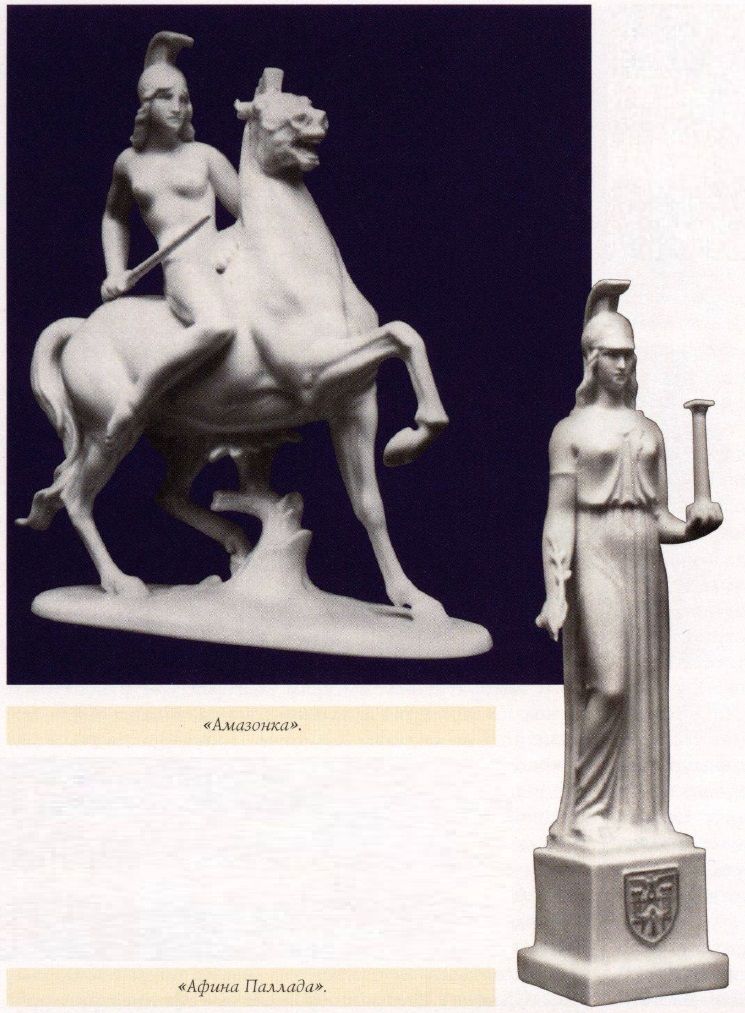 В системе мироздания нового германского общества Афина — греческая богиня войны и мудрости воспринималась как символ искусства и науки воинственной нации, символ германско- арийской культуры, что подразумевало преемственность греческой культуры. Неслучайно фигурку «Афины Паллады» никогда не раскрашивали, чтобы она своей белизной еще больше ассоциировалась с мраморной пластикой Древней Греции. Известно, что изображение богини также красовалось на медальоне германского ордена за заслуги в области науки и искусства, украшало Дом немецкого искусства и т. д.
В системе мироздания нового германского общества Афина — греческая богиня войны и мудрости воспринималась как символ искусства и науки воинственной нации, символ германско- арийской культуры, что подразумевало преемственность греческой культуры. Неслучайно фигурку «Афины Паллады» никогда не раскрашивали, чтобы она своей белизной еще больше ассоциировалась с мраморной пластикой Древней Греции. Известно, что изображение богини также красовалось на медальоне германского ордена за заслуги в области науки и искусства, украшало Дом немецкого искусства и т. д.
Еще одна не менее «античная» героиня из ассортимента этой мануфактуры — «Амазонка». Обнаженная женщина с оружием — тоже тема воинственной нации. Любопытно, что фигурки амазонок были в ассортименте почти любой фарфоровой мануфактуры того времени. Аллахское предприятие их, как и многие другие вещи, делало только для подарков и не выставляло в свободную продажу.
Истинные корни могучей нации должны были выражать так называемые мавританские (моррискенские) танцовщики (от англ, «моррис», фр. «мореск», исп. и нем. «мориск» — популярный в эпоху
 Средневековья танец в «восточном стиле»). Они представляли собой уменьшенные копии (в одну треть натуральной величины) позднеготических статуй немецкого скульптора Эразма Грассера, созданных около 1480 года для украшения танцевального зала мюнхенской ратуши (предположение о первоначальном местонахождении фигур, хранящихся в городском музее Мюнхена, было высказано в 1902 году). Из 16 статуй до наших дней сохранилось лишь 10. В фарфоре Р. Фёрстер повторил только 6 моделей, однако в производство были запущены лишь 5 из них. В программе мануфактуры они были призваны, в противовес анти- кизированным образам, олицетворять местные национальные традиции великой германской культуры, чьи истоки восходят к средним векам. Все фигурки, изготавливавшиеся с1939по1943 год, сделаны специально для подарков высокопоставленным лицам от города и никогда не продавались. Однако они были так популярны, что руководство мануфактуры решило создать еще одну серию танцовщиков. Она называлась «Шутники, или Обманщики», создавалась в подражание готическому искусству и олицетворяла целый пласт фольклорных образов карнавально-ярмарочной культуры средних веков. Самым известным из них был герой немецкого фольклора Тиль Уленшпигель.
Средневековья танец в «восточном стиле»). Они представляли собой уменьшенные копии (в одну треть натуральной величины) позднеготических статуй немецкого скульптора Эразма Грассера, созданных около 1480 года для украшения танцевального зала мюнхенской ратуши (предположение о первоначальном местонахождении фигур, хранящихся в городском музее Мюнхена, было высказано в 1902 году). Из 16 статуй до наших дней сохранилось лишь 10. В фарфоре Р. Фёрстер повторил только 6 моделей, однако в производство были запущены лишь 5 из них. В программе мануфактуры они были призваны, в противовес анти- кизированным образам, олицетворять местные национальные традиции великой германской культуры, чьи истоки восходят к средним векам. Все фигурки, изготавливавшиеся с1939по1943 год, сделаны специально для подарков высокопоставленным лицам от города и никогда не продавались. Однако они были так популярны, что руководство мануфактуры решило создать еще одну серию танцовщиков. Она называлась «Шутники, или Обманщики», создавалась в подражание готическому искусству и олицетворяла целый пласт фольклорных образов карнавально-ярмарочной культуры средних веков. Самым известным из них был герой немецкого фольклора Тиль Уленшпигель.
В том же духе выполнена еще одна статуэтка — «Куриный вор». Это не самостоятельное произведение мастеров мануфактуры, а реплика большой статуи фонтана, расположенного на площади птичьего рынка в Аахене (автор — Г.И.Пагель, 1911—1913). Веселый, задорный плут крадет, пряча за спиной, двух петухов, один из которых высовывает голову и кричит, тем самым обнаруживая вора. Создание реплик уже существовавших художественных произведений, возможно, объяснятся нехваткой художников и тяжелым экономическим положением предприятия в военные годы.

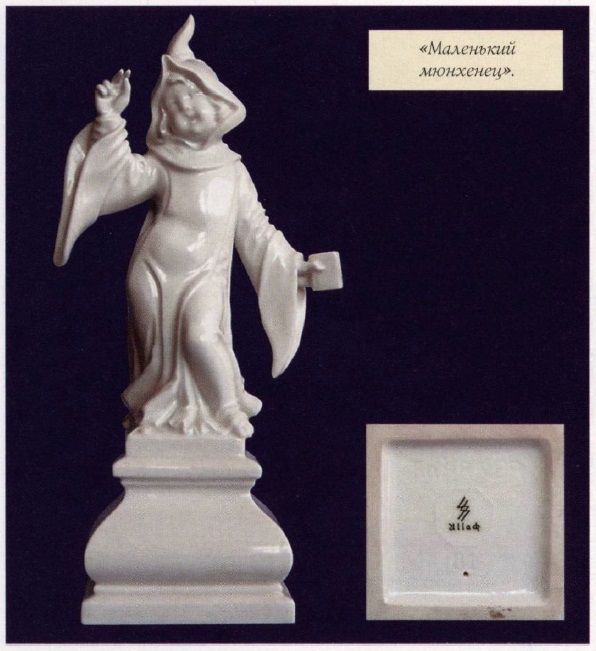 К числу идеологически значимых фигур следует отнести также «Знаки городов» Берлина и Мюнхена. Два важнейших города государства: первый — столица, второй — главный город нацистского движения, находившийся посередине между германской нордичностью и южной античностью. Символическими знаками стали — «Берлинский медведь» и «Маленький мюнхенец». Не сохранилось никаких указаний на назначение и использование этих фигурок. Поскольку они были выпущены большим тиражом, можно предположить, что это — сувенирная продукция, тоже задуманная в контексте общегосударственной культурной политики по формированию вкуса народа. Не исключено, что такие фигурки использовали в качестве призов в разнообразных состязаниях, на что указывает надпись на цоколе одной из них. Выполненная по модели Т.Кэрнера фигурка мюнхенца в средневековом монашеском хитоне с капюшоном, заимствованного с городского герба, стала одним из самых популярных изделий мануфактуры — только в 1938 году их было сделано 1802.
К числу идеологически значимых фигур следует отнести также «Знаки городов» Берлина и Мюнхена. Два важнейших города государства: первый — столица, второй — главный город нацистского движения, находившийся посередине между германской нордичностью и южной античностью. Символическими знаками стали — «Берлинский медведь» и «Маленький мюнхенец». Не сохранилось никаких указаний на назначение и использование этих фигурок. Поскольку они были выпущены большим тиражом, можно предположить, что это — сувенирная продукция, тоже задуманная в контексте общегосударственной культурной политики по формированию вкуса народа. Не исключено, что такие фигурки использовали в качестве призов в разнообразных состязаниях, на что указывает надпись на цоколе одной из них. Выполненная по модели Т.Кэрнера фигурка мюнхенца в средневековом монашеском хитоне с капюшоном, заимствованного с городского герба, стала одним из самых популярных изделий мануфактуры — только в 1938 году их было сделано 1802.
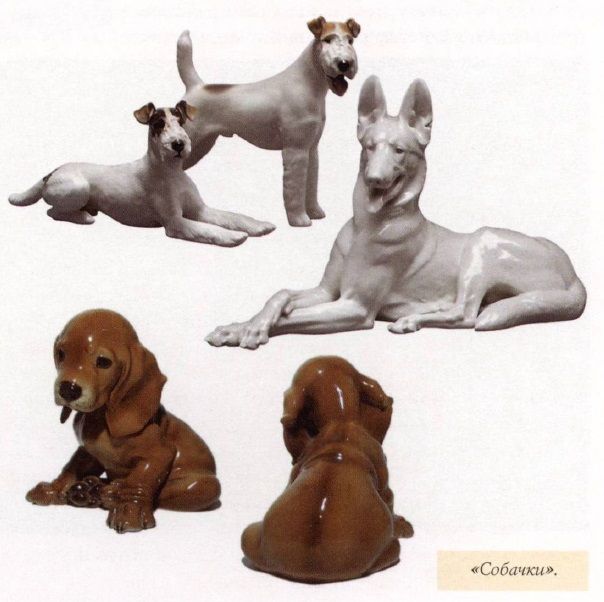 Очаровательные безделушки
Очаровательные безделушки
Еще одна популярнейшая тема мануфактуры — изображение животных. Для изящного искусства фарфора она тоже не нова. Фигурки зверюшек широко распространились еще в эпоху модерна, не в последнюю очередь благодаря Копенгагенской фарфоровой мануфактуре, и дали толчок к развитию этой темы в произведениях Нимфенбурга в начале XX столетия. Там, кстати сказать, большинство из них были исполнены по моделям работавших в то время Т.Кэрнера, В. Нойехаузера и В. Цугеля, позже, как и Т.Кэрнер, перешедших на предприятие в Аллахе.
Надо сказать, что тема животных — вообще одна из самых любимых в искусстве Третьего рейха. Так, например, в 1937 году в Берлине была проведена выставка произведений анималистического жанра «от XIX века до наших дней». И сама тема, и ее воплощение вызвали большой резонанс в прессе. Более того, на государственном уровне сформировалось даже представление о том, как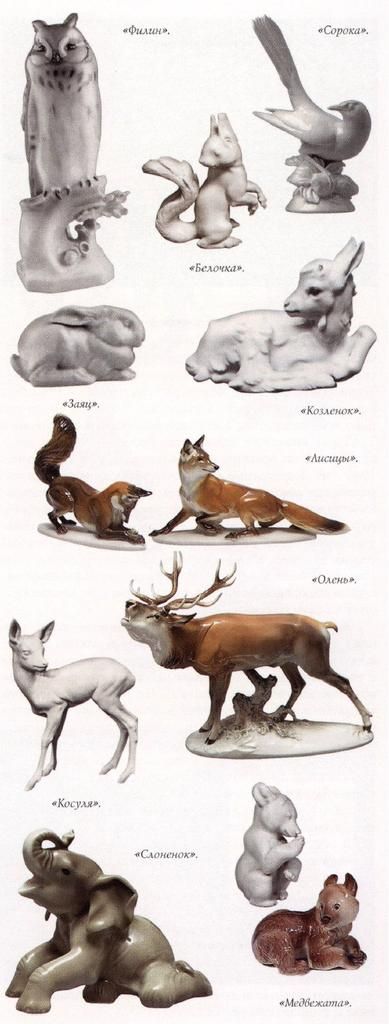 следует изображать животных. В этом отношении весьма показательно выступление директора Берлинского зоопарка по поводу состоявшейся выставки, который говорил о необходимости хорошо знать строение и повадки животного, чего не наблюдалось в авангардном искусстве 1920-х годов (в первую очередь, немецкого экспрессионизма).
следует изображать животных. В этом отношении весьма показательно выступление директора Берлинского зоопарка по поводу состоявшейся выставки, который говорил о необходимости хорошо знать строение и повадки животного, чего не наблюдалось в авангардном искусстве 1920-х годов (в первую очередь, немецкого экспрессионизма).
Изображение животных стало своеобразным выражением идеи близости германского народа к природе — отсюда требования правдоподобия и реализма. Известно, например, что в отличие от Г. Геринга Г. Гиммлер, как, впрочем, и А. Гитлер, был принципиальным противником охоты, считая, что она нарушает естественное состояние природы. После окончания войны он планировал ввести целый ряд законов по охране природы и животных. На государственном уровне не одобрялось ненатуралистическое изображение животных — неправдоподобного цвета, с неправильной анатомией, искаженными пропорциями. Был издан закон об охране национальных символов, в число которых попали и животные.
Однако предписанный натурализм в изображении животных не снижал их символической значимости. Например, в 1935 году Макс Эрнст, один из самых крупных немецких анималистов 1930—1940-х годов, опубликовал статью, в которой он дал семантическое определение изображениям зверей. Так, согласно этой, одобренной свыше версии, морская выдра олицетворяет вора, медведь — друга, бобер — строителя, отличного пловца и атлета, пантера — энергию и силу, дог — друга и помощника человека и так далее. Естественно, в этом контексте не был забыт и государственный символ — имперский орел.
Аллахские зверюшки стали, пожалуй, единственной продукцией, выпускавшейся для широкой продажи и заслужившей поистине всенародную любовь, в первую очередь благодаря правдоподобию и узнаваемости образа. Украшая комоды, камины, буфеты и другие предметы, они способствовали созданию уюта и душевной атмосферы в строго регламентированной обстановке жилища истинного германца, были своего рода аналогом мейсенской пластики. В ассортимент этой, пожалуй, самой обширной по количеству наименований группы изделий входят домашние, дикие и экзотические животные.
Среди первых лидерство по праву принадлежит собачкам разнообразных пород. Это овчарка и фокс, короткошерстные и длинношерстные таксы, терьер и бульдог, пинчер и даже очаровательная дворняжка (модели Т. Кэрнера, О. Обермайера, Ф. Наги). Все они охотно раскупались хозяевами домашних любимцев и были высоко оценены партийным руководством, а Т.Кэрнер заслужил славу отличного анималиста.
В числе домашних питомцев есть и кошка, и обитатели сельских ферм — овечки, барашки, ягнята и козлята (илл. 16). Возможно, не последнюю роль в выборе мотивов здесь сыграла широко распространенная в Германии многовековая традиция изображения фигурок животных для рождественских вертепов. К домашним животным относится и изображение «Прыгающей лошади». Тот факт, что именно эта фигура представлена на титульном листе каталога мануфактуры 1938—1939 годов, говорит о том, что ее считали, безусловно, удачной и репрезентативной. Сделана она по модели Т. Кэрнера, который уже изготавливал такие фигуры на мануфактурах в Розентале (1934) и в Ним- фенбурге (1935).
Дикие животные, или «Звери немецкого леса» аллахской мануфактуры — это лежащая или крадущаяся лисичка, лежащий или ревущий олень, косули, мышь, фазан, белочки, зайчики, медвежата. Так же, как и фигурки домашних зверюшек, они выполнены с соблюдением всех принципов реалистического, даже, можно сказать, подчеркнуто натуралистического искусства. Пожалуй, единственной, наделенной хоть каким-то символическим значением, могла быть фигура оленя, образ которого играет довольно важную роль в германской мифологии (именно олени запряжены в колесницу солнечного божества), а следовательно — тесно связана с широко распространенным культом света. Зайчик — самый популярный герой сказочного европейского фольклора, любимый народом пасхальный символ, а также всем известный герой знаменитой дюреровской акварели — исконно немецкий образ. Эта тема нашла свое отражение в изделиях и других фарфоровых мануфактур. Пример тому — вызвавшая огромный интерес экспозиция фарфоровых фигурок на интернациональной выставке «Охота».
К числу экзотических животных мануфактуры можно отнести разве что слонов, популярность которых в европейских культурах связана в первую очередь с цирковыми выступлениями, их зрелищностью. Довольно грозное в природе животное изображено здесь прирученным, дрессированным и подчинившимся человеку, его могучей воле.
Символы власти и ее герои
 Не осталась незатронутой и тема знаков власти. Известны как минимум два примера изображения фигуры имперского орла в пластике мануфактуры. Одна из этих моделей, из серо-коричневой неглазурованной глины, исполненная по модели В. Кригера, представляла собой немноготиражное и очень дорогое, эксклюзивное изделие, предназначенное, скорее всего, для государственных учреждений. Второй вариант, известный по деревянной скульптуре Т. Кэрнера, был изготовлен всего в трех экземплярах по личному заказу Г. Гиммлера для зала суда в Вевельсберге (место принесения торжественной клятвы руководителя СС). Орел, украшенный свастикой и венком из дубовых листьев, с головой, повернутой влево (как у партийного орла), получил название «Орел власти».
Не осталась незатронутой и тема знаков власти. Известны как минимум два примера изображения фигуры имперского орла в пластике мануфактуры. Одна из этих моделей, из серо-коричневой неглазурованной глины, исполненная по модели В. Кригера, представляла собой немноготиражное и очень дорогое, эксклюзивное изделие, предназначенное, скорее всего, для государственных учреждений. Второй вариант, известный по деревянной скульптуре Т. Кэрнера, был изготовлен всего в трех экземплярах по личному заказу Г. Гиммлера для зала суда в Вевельсберге (место принесения торжественной клятвы руководителя СС). Орел, украшенный свастикой и венком из дубовых листьев, с головой, повернутой влево (как у партийного орла), получил название «Орел власти».
К таким же значительным изделиям мануфактуры относятся портретные изображения. Среди них — керамическая голова Гитлера (илл. 20, автор — О. Обермайер) и фарфоровая — Геринга (Р. Фёрстер). Если первую с 1940 года мануфактура планировала выпускать серийно, то вторая была исполнена лишь в качестве эксклюзивного изделия в 1943 году, возможно, как вариант бронзового бюста, представленного на Большой выставке германского искусства в 1941 году. В программе мануфактуры керамика воспринималась как материал исключительный, противопоставленный тонкому изысканному аристократическому фарфору. Керамика — самый простой, доступный материал, используемый человеком с давних времен, и в то же время это материал, из которого во всех древних мифах и религиях боги делали человека. Именно в керамике художники мануфактуры воплощали самые значимые произведения, непосредственно связанные с верховной властью.
Любопытно, что еще одно произведение — голова «Воина в шлеме» (Т. Кэрнер), тоже из неглазурованной серо-голубой керамики — было в два раза дороже головы Гитлера и тоже, очевидно, не предназначалось для широкой продажи. Известно, что уже с начала 1930-х годов голова Гитлера вошла в моду как декоративный мотив. Посуда с портретом фюрера пользовалась спросом, появился фарфор с нацистской символикой, с цветами партии (белым, черным, красным). Однако, испугавшись дискриминации образа партии и насмешек, правительство прекратило это «бесчинство» указом 1933 года. Отныне правом изображать фюрера или партийную символику обладали лишь избранные предприятия, в числе которых оказалось и Аллахское.
В общем и целом перечисленными выше изделиями ограничивается ассортимент мелкой пластики мануфактуры, однако не исчерпывается номенклатура изделий. Как уже упоминалось, здесь изготавливали и другие изделия, нефигуративные, которые не были главными в работе предприятия. Эти произведения менее эксклюзивны, но зато уж точно многочисленны по тиражу. К этим произведениям мануфактуры относятся преимущественно изделия с нацистской символикой: свастикой, меандровым орнаментом, рунами и другими знаками. Как правило, это была серийная продукция.
Свет физический и метафизический
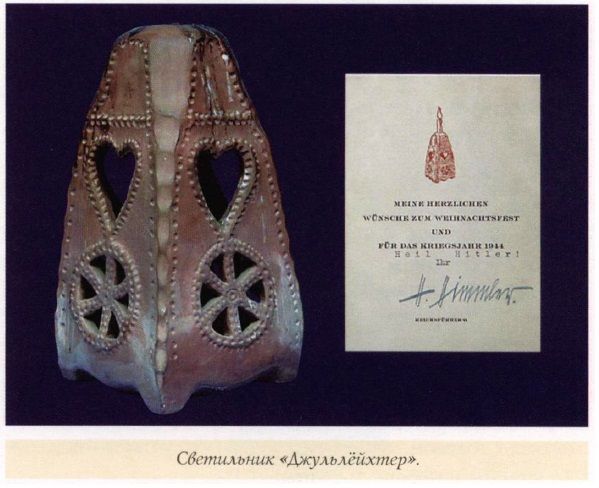 Наиболее популярными среди нефигуративных изделий мануфактуры были подсвечники. Некоторые из них представляют собой вариации на тему варварских изделий первых веков нашей эры, археологических культур древних времен. Другие — банальные вариации ширпотреба XIX века.
Наиболее популярными среди нефигуративных изделий мануфактуры были подсвечники. Некоторые из них представляют собой вариации на тему варварских изделий первых веков нашей эры, археологических культур древних времен. Другие — банальные вариации ширпотреба XIX века.
К числу самых известных произведений данной группы относится особой формы терракотовый светильник, так называемый «Джульлёйхтер» — подарок к «Джульфесту», языческому празднику середины зимы, на который с приходом христианства наложилось Рождество. По особому указу А. Гитлера он стал главным праздником государства, мощь которого восходит к языческим временам. Он был назначен на 22 декабря — день зимнего солнцестояния, что стало одним из первых шагов на пути замены христианства языческой религией древних германцев, где ключевую роль играл образ света (одним из проявлений которого было вращающееся по небу солнце, а его символом и была свастика).
древних германцев, где ключевую роль играл образ света (одним из проявлений которого было вращающееся по небу солнце, а его символом и была свастика).
Специальный светильник впервые появился в 1935 году. Он был изготовлен на Аллахской мануфактуре как подарок Г. Гиммлеру, по образцу древнегерманского светильника, найденного в археологических раскопках. Впоследствии его выпускали как подарок для офицеров СС, который был признан знаком особого почета.
Светильник имеет форму немного усеченной пирамиды около 20 см высотой со стенками, прорезанными в форме сердца и шестиспицевого колеса. Края символов и стенок подчеркнуты рельефными кантами с нерегулярными прорезанными «штрихами», указывающими на руко- творность исполнения. В светильник вставляются две свечи: внутрь и на верхнюю площадку. Маленький свет внизу — символ уходящего года, большой на светильнике — начало нового. Именно от этой свечи предписывалось зажигать рождественскую елку.
По аналогии с днем зимнего солнцестояния в июле 1939 года Г. Гиммлер решил устроить праздник в честь дня летнего солнцестояния. Был изготовлен аналогичный светильник, на сей раз из фарфора, чтобы он отличался от прежнего. Согласно древнегерманской традиции, летнее солнцестояние — это время заключения новых браков и зачатия детей. Таким образом, праздник зимнего солнцестояния посвящен прошлому, летнего — обращен в будущее.
В соответствии с новой картиной мира, фарфоровая мануфактура Аллаха выпустила бесчисленное множество подсвечников, исполненных в подражание самым разным стилям прошлых эпох, в разных техниках и в разных ценовых категориях, что позволяло представителям практически всех слоев немецкого общества приобретать вещь главной официальной фарфоровой мануфактуры страны.
Большинство подсвечников имеет пластичную, почти скульптурную псевдобарочную форму, основанную на изгибающихся элементах растительного орнамента. Она выдает образцы, на которые ориентировались мастера мануфактуры, — теперь это не изысканное рококо немецких мануфактур времен изобретения фарфора, а исторический стиль XIX столетия, столь любимый в рейхсканцелярии времен прусской военной мощи.
Светильник характерной, напоминающей об античных жертвенниках формы с фризом, изображающим детей (аллюзия на ренессансные рельефы с путти), на ножках в виде закручивающихся свитков (или волют) был специально разработан как подарочное изделие для семей офицеров СС, у которых родился четвертый ребенок, и получил название «светильник жизни».
Отличительные знаки
Целый пласт изделий мануфактуры составляют декоративные тарелки и плакетки, украшенные широко разработанной нацистской символикой, снабженные посвятительными надписями и изготовленные, как правило, в единичном экземпляре.
Для подарков к главным праздникам страны были созданы тарелки «Джультеллер». Большинство из них исполнено специально по заказу Г.Гиммлера, который собственноручно вручал их своим офицерам и служащим других ведомств. Обычно их делали из белого глазурованного фарфора и украшали рельефными изображениями рун или символами различных организаций. Известна, например, модель так и не пущенной в производство тарелки с Крестом Почета германской матери в центре, окруженным «венком» из дубовых листьев, чередующихся с железным крестом. По кругу — надпись: «К победе, благодаря нашим матерям и героям». Расписные тарелки с изображением цветов и поэтическими цитатами обычно делали по заказу Освальда Поля, экономического шефа ведомства Г. Гиммлера.
Из столовой сильных мира
 Посуда Аллахской мануфактуры — явление сегодня в полной мере уникальное. Мы уже видели, что собственно изготовлением посуды она не занималась. Однако здесь все же делали исключение для заказов фюрера или шефа СС. Большие столовые и чайные сервизы обычно производились в качестве подарков ко дню рождения или крупным праздникам А. Гитлеру, Г. Гиммлеру и другим высокопоставленным лицам государства. Предметы этих сервизов имеют четкие, строго выверенные формы, напоминающие об изящных порцеланах эпохи классицизма. Как правило, они оставлены нераскрашенными, а их сахарную белизну только подчеркивают небольшие геральдические орлы рейха или фюрера, — единственное украшение чашек и тарелок. Исключением в этом ряду могут оказаться, пожалуй, лишь сервизы, исполненные для страстного охотника Г. Геринга, в формах рококо, с пасторальными и охотничьими сценками.
Посуда Аллахской мануфактуры — явление сегодня в полной мере уникальное. Мы уже видели, что собственно изготовлением посуды она не занималась. Однако здесь все же делали исключение для заказов фюрера или шефа СС. Большие столовые и чайные сервизы обычно производились в качестве подарков ко дню рождения или крупным праздникам А. Гитлеру, Г. Гиммлеру и другим высокопоставленным лицам государства. Предметы этих сервизов имеют четкие, строго выверенные формы, напоминающие об изящных порцеланах эпохи классицизма. Как правило, они оставлены нераскрашенными, а их сахарную белизну только подчеркивают небольшие геральдические орлы рейха или фюрера, — единственное украшение чашек и тарелок. Исключением в этом ряду могут оказаться, пожалуй, лишь сервизы, исполненные для страстного охотника Г. Геринга, в формах рококо, с пасторальными и охотничьими сценками.
Товар для народа

 Единственным предметом обихода, разработанным для массового производства, стали вазы. По форме они делятся на два типа. Вазы одного типа имитируют античные сосуды, другого — необыкновенно лаконичные, простых геометризованных форм сосуды, очень скромно украшенные строгим геометрическим орнаментом в виде горизонтальных полос разной ширины.
Единственным предметом обихода, разработанным для массового производства, стали вазы. По форме они делятся на два типа. Вазы одного типа имитируют античные сосуды, другого — необыкновенно лаконичные, простых геометризованных форм сосуды, очень скромно украшенные строгим геометрическим орнаментом в виде горизонтальных полос разной ширины.
Бытование и иены
Итак, на главном фарфоровом предприятии гитлеровской Германии преобладала мелкая пластика, менее значительную роль играли нефигуративные репрезентативные изделия и почти полностью отсутствовали предметы быта.
Изделия мануфактуры сегодня очень ценятся коллекционерами, а также теми, кто интересуется искусством фарфора или германской историей. На рынке они представлены нешироко и не везде. Нельзя забывать, что в отличие от таких известных старинных фарфоровых мануфактур, как Мейсен, Нимфенбург или даже Розенталь, мануфактура в Аллахе существовала очень недолго, а ее произведения гибли вместе со своими хозяевами во время бомбежек. Приобрести их можно, вероятнее всего, на торгах знаменитых аукционных домов, нежели на Интернет аукционах или в небольших антикварных лавках, где аллахский порцелан — большая редкость, тем более это редкость — на блошиных рынках, где большинство торгующих даже не слышали о том, что в Германии когда-либо вообще существовала мануфактура с таким названием.
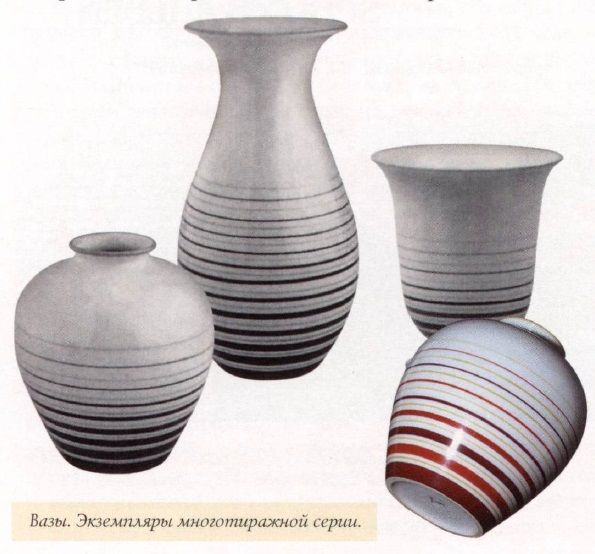 К числу вероятных и доступных покупок, в первую очередь, относятся серийные вазы и подсвечники, в частности знаменитый «Джульлёйхтер», ставший едва ли не обязательным предметом в каждой германской семье того времени. Цены на эти изделия колеблются от 100 евро (за упомянутый «Джульлёйхтер») до 500 евро (за другие позиции), в зависимости от тиража и размера вещи. Немного дороже — фигурки животных. Большой тираж и отсутствие прямого идеологического значения, обеспечившего этим произведениям мануфактуры спокойное существование в послевоенные годы, делают их достаточно частыми гостями антикварного рынка. Приобрести их можно и через Интернет у именитых и не очень торговцев антиквариата, и в магазинах «военного антиквариата» в Москве. В среднем цены на эти изделия колеблются от 1000 до 2000 евро. Так, самые «дешевые» — более распространенные фигурки мишек (борющихся, вынимающих занозу или облизывающих лапу), за которые можно отдать примерно 1150—1250 евро, немного дороже обойдутся фигурки лисичек, фокстерьеров, такс — от 1200 до 1400 евро. За ними следуют белочки, оленята, козлята, зайки — от 1600 до 1800 евро за фигурку. Однако цены на более редкие изделия, такие, как фигурка овчарки, могут доходить до 3500 — 4000 евро. Надо упомянуть и о довольно распространенных многотиражных сувенирах — «маленьких мюнхенцах», за которых сегодня просят от 1000 до 1500 евро.
К числу вероятных и доступных покупок, в первую очередь, относятся серийные вазы и подсвечники, в частности знаменитый «Джульлёйхтер», ставший едва ли не обязательным предметом в каждой германской семье того времени. Цены на эти изделия колеблются от 100 евро (за упомянутый «Джульлёйхтер») до 500 евро (за другие позиции), в зависимости от тиража и размера вещи. Немного дороже — фигурки животных. Большой тираж и отсутствие прямого идеологического значения, обеспечившего этим произведениям мануфактуры спокойное существование в послевоенные годы, делают их достаточно частыми гостями антикварного рынка. Приобрести их можно и через Интернет у именитых и не очень торговцев антиквариата, и в магазинах «военного антиквариата» в Москве. В среднем цены на эти изделия колеблются от 1000 до 2000 евро. Так, самые «дешевые» — более распространенные фигурки мишек (борющихся, вынимающих занозу или облизывающих лапу), за которые можно отдать примерно 1150—1250 евро, немного дороже обойдутся фигурки лисичек, фокстерьеров, такс — от 1200 до 1400 евро. За ними следуют белочки, оленята, козлята, зайки — от 1600 до 1800 евро за фигурку. Однако цены на более редкие изделия, такие, как фигурка овчарки, могут доходить до 3500 — 4000 евро. Надо упомянуть и о довольно распространенных многотиражных сувенирах — «маленьких мюнхенцах», за которых сегодня просят от 1000 до 1500 евро.
Далее следуют тоже довольно распространенные, но более сложные по моделировке фигурки амазонки, купальщиц, матери с ребенком, гитлерюгендовского горниста и крестьян, цены на них исчисляются уже несколькими тысячами, в среднем от 6500 до 8500 евро.
Куда как более редкими, а потому и дорогими (в прямом смысле этого слова) гостями рынка являются фигуры, исполнявшиеся по специальным заказам небольшими партиями для подарков высокопоставленным эссесовцам и сподвижникам фюрера. Среди изделий — фигуры военных (как прежних эпох, так и нацистского периода) и спортсменов. Цены на эту эксклюзивную продукцию мануфактуры исчисляются уже десятками тысяч. Однако привести среднюю стоимость этих изделий невозможно, ибо в зависимости от уникальности и сохранности вещи они могут быть очень разными. Так, в качестве примера, можно привести знаменитую фигурку фехтовальщика, которая крайне редко встречается в полной сохранности, с несломанной рапирой, что может удорожить ее примерно на 15 000 евро. А те вещи, что изготавливали недолго, как, например, аллегории времен года, в последнее время вообще не встречаются.
К разряду уникальных приобретений можно отнести также именные плакетки, памятные чаши и тарелки, стоимость которых доходит до 10 000—-20 000 евро (против 1200—-2800 евро за их безымянных собратьев). Предметы сервизов самого фюрера или его сподвижников тоже могут оказаться на столе (или в витрине) у расторопного любителя истории, за тарелку из такого сервиза придется выложить от 1250 до 1500 долларов), а за так и не доставленный в 1945 году подарок фюреру — чайный сервиз для 2-х персон — 9500 долларов.
И уж совсем редкими стали сегодня некогда популярные в рядовых германских квартирах, а затем активно уничтожавшиеся бюсты Гитлера, владелец которых может сегодня рассчитывать на 50 000 евро.
Завершая обзор рынка аллахского порцелана, хочется предостеречь начинающего коллекционера от необдуманных покупок, без предварительного изучения марки мануфактуры. Большое количество моделей, разработанных для аллахского производства, с закрытием мануфактуры переехали вместе с их авторами, например, знаменитым модельером Т.Кэрнером, на другие предприятия в Нимфенбург и Розенталь. В первую очередь, это касается очень популярных и довольно доступных сегодня фигурок животных, зачастую прямо повторяющих аллахские, однако на самом деле не столь редких (а, следовательно, недорогих) и вообще не имеющих отношения к истории немецкой мануфактуры Аллах-Мюнхен, прожившей недолго, но ярко, и разделившей участь ее создателей.
Анастасия КОРОЛЕВА
Иллюстрации предоставлены автором.
Журнал «Антиквариат, предметы искусства и коллекционирования», № 57 (май 2008), стр.4
